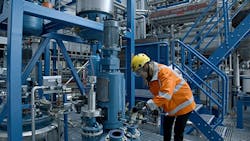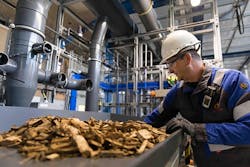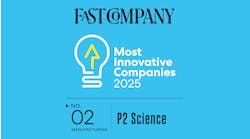Circular chemistry — an approach to manufacturing that focuses on leveraging renewable feedstocks and end-of-life materials — continues to advance apace with chemical companies’ increasing emphasis on improving their sustainability. Recent developments from the Technical Research Center of Finland (VTT), Enerkem, Avantium, Futerro, ADM and Spiber promise to add to the momentum.
In late September 2020, VTT opened a new platform for process chemistry at its Bioruukki pilot center in Espoo, Finland, bringing its investment there to €35 million (≈$42 million) since 2014. The new platform (Figure 1) joins three others: thermochemical conversion, biomass processing and textile fiber manufacturing. All aim to scale up new ideas and methods verified in laboratory conditions to industrial scale.
A key area for research at VTT is polysaccharides, especially cellulose and hemi-cellulose from biomass materials such as starch. Tailoring and modifying their chemical structure enables the molecules’ use, for example, in barrier or film applications for packaging.
“Over the years, we have developed various ‘tricks’ for dealing with polysaccharides and chemically modify[ing] their properties. For example, we can control cellulose molecular weight via enzymatic treatment and then modify it with a fatty acid to give a thermoplastic material which can use the normal pelletizing process and equipment,” says VTT vice president Tuulamari Helaja. “Typical production scale is about 100 kg, so enough for customers to test samples,” she adds.
Sugar-based chemistry also is important. In this area, VTT has created platform chemicals including muconic acid, xylonic acid and furandicarboxylic acid (FDCA) — an oxidized furan derivative and valuable building block for a range of polymers.
In the case of FDCA, VTT’s patented technology exploits a novel synthesis route. The proprietary process starts with orange peel or sugar beetroot pulp, extracts pectin and reacts it to aldaric acid. The aldaric acid then is transformed to FDCA in an aromatization step.
The aldaric acid intermediate is much more stable than the 5-(methoxymethyl)furfural and 5-hydroxymethylfurfural intermediates generated in the more common route, notes VTT.
A polycondensation reaction of FDCA with ethylene glycol produces polyethylene furanoate (PEF), which the Finnish group foresees as a potential replacement for the 60-million mt/y fossil-fuel-based PET used as a packing material. Earlier research has shown PEF to have a 40–55% lower carbon footprint than PET. It also was found to provide a ten times better oxygen barrier, a four times better carbon dioxide barrier, and twice as effective a barrier to water.
“We are offering an attractive route to PEF. At the same time, our biotechnology solution allows the exploitation of biomass waste streams into other useful platform chemicals such as muconic acid and xylonic acid,” comments Holger Pöhler, professor of practice at VTT.
“Biotechnology is one of our core competencies, too, and we are working with fermentation processes at the 10–200-L scale now. Yields are quite low at the moment — 20–40 kg/week — and still at the pilot scale,” he adds.
Figure 1. Finish research group has added capabilities for biomass-based piloting and scale up. Source: VTT.
Broader Role
The value of the Bioruukki pilot center goes beyond developing the chemistry. “In the case of the process chemistry pilot platform, its 100–1,000-kg capacity is big enough to give a good insight into the process engineering and the application testing and economics involved with different products,” says Mika Härkönen, manager, operations support at VTT.
A good example of this in action is a start-up company in Finland that is working with VTT on processes for making cellulose-based textile fibers, he notes. Bioruukki is generating the data needed to take the process to demonstration stage.
This intermediate step between the lab-scale and large-scale manufacturing is the biggest problem with developing such new processes, according to Pöhler. “Before you go to large-scale manufacturing, you need to assess general scalability — such as mass and heat transfer, side products, etc. — to reduce the risk to fail at manufacturing. Companies lack this intermediate infrastructure. We are often asked: ‘Can we run our new process in your 600-L reactor and get 200 kg of product?’ This is happening in very many projects.”
A paradigm shift is occurring in the thinking about the economics of new processes, believes Pöhler. Driven both by the industry and new targets set for carbon neutrality and greenhouse-gas emissions around the world, sustainability is becoming a priority, he stresses.
“The performance of bio-based materials is very similar to that of existing polymers, so there is a momentum to use them now,” Pöhler adds.
However, finding funding is an issue. “Support to larger capex projects needed to keep our pilots competitive falls between two stools — national and EU [European Union]. The cost of an intermediate-size pilot plant is typically €1–10 million (≈$1.2 –12 million), and the challenge is that the EU is not so willing to supply capex for them and the sums are often too large for national funding bodies of EU member states,” says Härkönen.
When VTT can’t get all the equipment needed for a pilot plant, it works actively with the Pilots4U open-access bio-economy pilot network and database that provides access to complementary piloting services.
Push For PEF
Avantium, Amsterdam, the Netherlands, also is eyeing the potential of PEF. Seconding VTT, the Dutch company cites superior performance properties compared to today’s widely used petroleum-based packaging materials, adding that PEF is a 100% plant-based, 100% recyclable and degradable plastic.
Avantium is focusing on commercializing its two lead products, FDCA and plant-based monoethylene glycol (MEG), the two building blocks to make PEF. It aims to take FDCA commercial scale first, with commercialization of plant-based MEG to follow.
The company uses its proprietary Renewable Polymers YXY catalytic conversion technology to produce FDCA — and currently is mulling a 5,000-mt/y plant to manufacture FDCA at Chemie Park Delfzijl, Delfzijl, the Netherlands, that would start production in 2023. The plant will cost about €150 million (≈$180 million). Front-end engineering design already has started; Avantium hopes to have financing in place by the end of 2020.
Figure 2. Proprietary technology produces industrial sugars and lignin from forestry and agricultural residues at pilot biorefinery. Source: Avantium.
For MEG, the company uses its proprietary Ray Technology to convert industrial sugars into MEG via a single-step catalytic process. In early 2020, Avantium commissioned a 10-mt/y pilot plant, also at Delfzijl, to scale up and further optimize the technology and to validate its economics for product applications.
Discussions are ongoing with several potential partners about bringing Ray Technology to full-scale global commercialization.
Meanwhile, the company’s Dawn Technology produces industrial sugars and lignin from forestry and agricultural residues. The industrial sugars can serve as feedstocks in processes making a broad range of chemicals and materials.
A pilot biorefinery (Figure 2) opened at Delfzijl in 2018; since then, trial runs with feedstocks from several partners have optimized the technology further.
In April 2020, the Netherlands Enterprise Agency awarded Avantium €0.5m (≈$0.6 million) to produce lignin for the development of bio-based asphalt. Large-scale paving of four test roads began in November.
Renewed Relevance
Meanwhile, Enerkem, Montréal, is developing a four-step thermochemical process — involving feedstock preparation, gasification, cleaning and conditioning of syngas, and catalytic synthesis — to convert non-recyclable, non-compostable municipal solid waste (MSW) into methanol, ethanol and other widely used chemicals.
“We think our technology is uniquely useful in the circular economy, one reason being it is feedstock agnostic. We can handle 100% plastic all the way to 100% biomass feedstock if needed and, in fact, that is what the technology was originally created to do during the 1970s fuel crisis. However, as that crisis receded, the demand for biomass-based fuel did, too,” notes Peter J. Nieuwenhuizen, Amersfoort, the Netherlands-based vice president, technology strategy & deployment.
Nearly 50 years later, the situation has come full circle; the company has a new plant in Montréal that handles almost 100% forestry biomass. Its single train produces about 100 kt/y of methanol. “Finance and government support is currently being sought for another in Rotterdam, which will use waste composed of a 55%/45% mix of biomass/plastic and use two trains to manufacture 230 kt/y of methanol,” he adds.
While the calorific value of biomass feedstock is lower, for example, than that of mixed waste, the process itself stays the same.
However, while the trains are linked in parallel to increase production capacity, two really is the optimum number in most cases, he cautions. A two-train setup is capex-efficient but not so big as to run into feedstock supply issues — logistics is a crucial consideration for biomass because supplies must be nearby.
Nieuwenhuizen also points out the economic arguments at play: “Biomass typically costs ≈$50/t for procurement, whereas MSW attracts a tipping fee of about the same amount. But when we make biofuels from biomass, we get support in EU and U.S. under RED/REDII in the EU and RFS/LCFS in the U.S. legislation.”
Chinese Plant
In October, Futerro, a subsidiary of Galactic, Brussels, Belgium, started operating an integrated polylactic acid (PLA) production unit at Bengbu, China, in collaboration with its long-term partner there BBCA Biochemical.
PLA is a bioplastic made of lactic acid (LA), which itself is produced by the fermentation of corn sugar or any other form of carbohydrate from biomass.
The new plant has a capacity of 30,000 mt/y and gets LA from an 80,000-mt/y unit that also supplies another Galactic company at Bengbu that uses it as a food ingredient.
Since 2007, Futerro has been developing technology to produce PLA from renewable vegetable resources such as sugar beet, sugar cane, wheat, corn and cellulose. Development work took place at a 1,500-mt/y demonstration unit at Galactic’s production site in Escanaffles, Belgium.
The resulting two-step process involves the synthesis of the cyclic dimer of lactic acid — lactide — which then undergoes ring-opening polymerization to produce a PLA with high molecular weights offering attractive mechanical properties.
The work at Escanaffles focused on producing a very high quality PLA with what the company describes as exceptional and controlled optical purity while using low-temperature technologies to avoid degradation or racemization of the products in the production process.
PLA itself has found use for many years in medical applications, such as stitches, because lactic acid has a high level of biocompatibility with humans.
However, the new Chinese plant opens up a range of novel opportunities —other companies in Bengbu intend to use PLA in food packaging, films, foams, insulation products, textile fibers, 3D filaments, cases for electronics, furniture, carpets, bedding, filters, bottles and cans, and auto parts.
Futerro and BBCA already are planning to increase LA production to 180,000 mt/y and PLA output to 100,000 mt/y.
The Belgian company is offering licenses for the production of LA and PLA and LOOPLA — a new recycling process for converting the polymer back to its constituent monomers.
Protein Polymers
Also in October, ADM, Chicago, and biotech start-up Spiber, Tsuroka, Japan, announced an agreement to expand the production of Spiber’s Brewed Protein polymers for use in apparel and other consumer products.
ADM brings to the pact its expertise in large-scale fermentation technologies, engineering, operations and an extensive agricultural supply chain while Spiber brings its proprietary fermentation process to make protein materials from plant-derived biomass. These materials can be processed into a wide variety of forms, from delicate filament fibers to resins suitable for lightweight composite materials.
The collaboration comes a year after the companies began initial work together to help develop and test Spiber’s process at scale. They now will strive to create a pathway to commercial-scale production over the coming years.
The plan is for the polymers to be produced by ADM in the U.S. using plant-based dextrose as a feedstock and then shipped to Spiber downstream facilities for further processing.
Seán Ottewell is Chemical Processing's editor at large. You can email him at [email protected].





